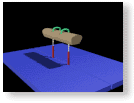
 |
|||||||||||||
 |
 |
A contemporary Pommel Horse exercise is characterized by pendulum swings
and by different types of circular swings with legs apart and together
in a variety of support positions on all parts of the horse. Swings
through the handstand position, with or without turns, are permitted.
All elements must be executed with swing and without the slightest interruption
of the exercise. Strength and hold elements are not permitted. description taken from the official men's FIG Code of Points
Below I have listed skills performed on this apparatus, their Element
Group and their value. All skills and skill sequences listed below are
evaluated with FIG rules, not USAG JO rules. |
||||||||||||||||||||||||
|
Animated Skills Thomas
Flairs - flaired (legs apart) circles |
||||||||||||||||||||||||||
USA
Gymnastics Men's Program | National
Gymnastics Judges Association | NCAA
Men's Gymnastics | FIG
Gymnastics
| Home
|
||||||||||||||||||||||||||
|
©
1998 - 2002
thedigitalman |
||||||||||||||||||||||||||